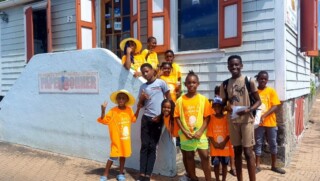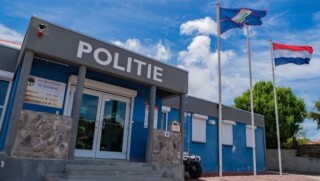New Butterfly Census for the Dutch Caribbean Windward Islands

Oranjestad, St. Eustatius – The results of a four-year study were just published, cataloging the butterfly species of St. Eustatius over the winter months of 2009-2012. This project also provided an update to species lists for the Dutch Caribbean islands of St. Eustatius, Saba and St. Maarten. The butterfly faunas of the three islands totals 44 species, including seven new species records for St. Eustatius. By comparing butterfly populations between different habitat types, the researchers determined which factors are important for increasing local diversity.
Aside from being a colorful addition to any garden, butterflies are of great importance to local ecosystems. Butterflies are often used as an indicator for the health of a particular environment. For example, dense and diverse butterfly populations typically correspond to areas of equally dense and diverse plant life and other invertebrates, which often include important pollinators and natural pest control. Furthermore, because butterflies are so sensitive to changes in their environment, ecologists can use them to study the overarching impacts of climate change, urbanization and habitat loss within a specific area.
Bridging the Knowledge Gap
Although these species have great ecological importance, very little is known about the species-specific distribution throughout most of the Caribbean. To narrow this knowledge gap, researchers from Wageningen Marine Research, St. Eustatius National Parks Foundation (STENAPA), Caribbean Netherlands Science Institute (CNSI), Wageningen University, Carmabi Foundation Curaçao and the University of Florida monitored butterflies on St. Eustatius. Studying various natural habitats, the butterfly populations within the three windward Dutch islands were compared to those of neighboring islands. Along with visual surveys, literature records for nine nearby islands were also collected to compile a more complete list of known butterfly species.
Local Fauna & Flora
This study monitored butterflies on St. Eustatius over the winter months (January-April) for four years (2009-2012) along transects of four different habitats. These habitats were the Quill crater, Quill flanks (wind sheltered, southwestern side), lower Quill flanks (of the outskirts of Oranjestad) and the northern hills. This project also provided updated species lists for the neighboring islands of Saba and St. Maarten. In total, 44 species of butterflies were identified between the three islands, including seven new species on St. Eustatius.
Of the 44 documented species, nearly half were from the Pieridae family, a butterfly group known for being large, strong and fast flying. These butterflies were noted in each of the four different habitat types. The second most common butterfly was from the Lycaenidae family, a physically smaller group of butterflies known to inhabit dry, resource-limited areas. These species were found in all but one habitat, the Quill crater.
The availability of larval host plants determine if local butterflies are capable of reproducing on the island. Larval host plants were documented as being present for all but 2 of the butterfly species and seems breeding possible for the other 42 species.
Importance of Elevation
Traditionally it was believed that land area was the greatest limiting factor for butterflies, however, this study along with previous studies show that habitat diversity and elevation play a more important role. Even though St. Eustatius and Saba are smaller in size than neighboring islands, they host a large number of total butterfly species. Understanding the geology, urbanization, agricultural history and other human factors on an island can give insight into the struggles facing these species. Deforestation, overgrazing by feral livestock and the use of insecticides can greatly reduce local butterfly populations.
Having an updated species list for resident butterfly populations will aid in conservation efforts on these islands. Since they are an important indicator species, they can help sound the alarm for larger ecological trends that could be adversely affecting these islands. This research will help guide local conservation efforts leading into the future.
Butterflies of the ABC-islands
For those interested, similar work is already available for the leeward Dutch islands. The guide book Butterflies and moths of Curacao, Aruba and Bonaire, by Debrot and Miller provides full-color pictures and information on 78 species found in the ABC-islands. The book can be obtained through Carmabi and in bookstores.
Report your butterflies’ sightings:
Be sure to place your sightings (and photographs) on: https://dutchcaribbean.observation.org/ or download the free apps.
This free website and free apps can be used not only by biologists but by all citizens to report any animals and plants and is available in more than 40 languages. The species reports by local communities are very valuable for the nature conservation organization to learn and protect the species on our islands.
For more information on butterflies see: Debrot, A.O., Madden, H., Becking, L.E., Rojer, A., and Miller, J.Y. (2020) The butterflies of St. Eustatius with faunal comparisons among the adjacent islands of the Lesser Antilles. Caribbean Journal of Science, 50(1) : 91-106. https://doi.org/10.18475/cjos.v50i1.a12










